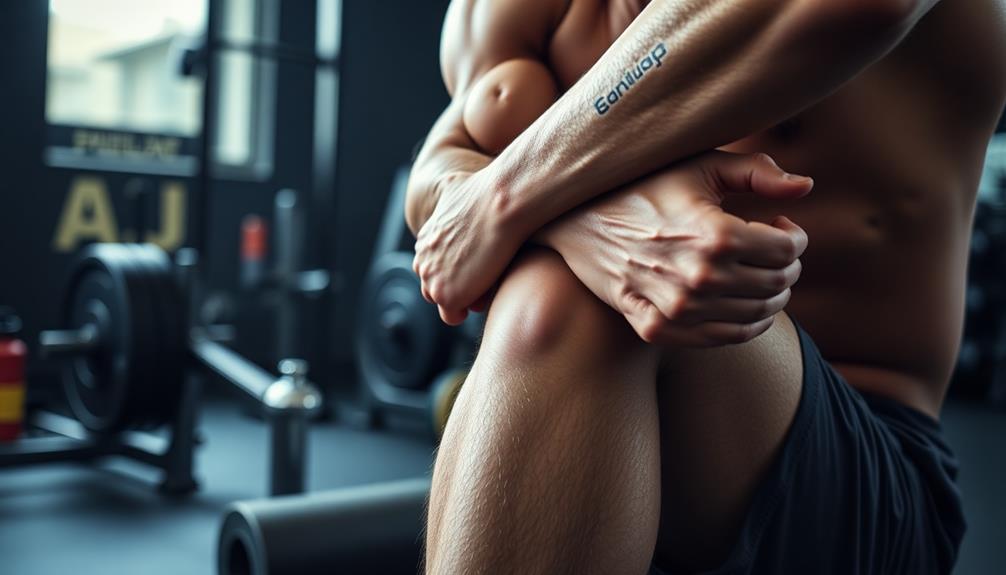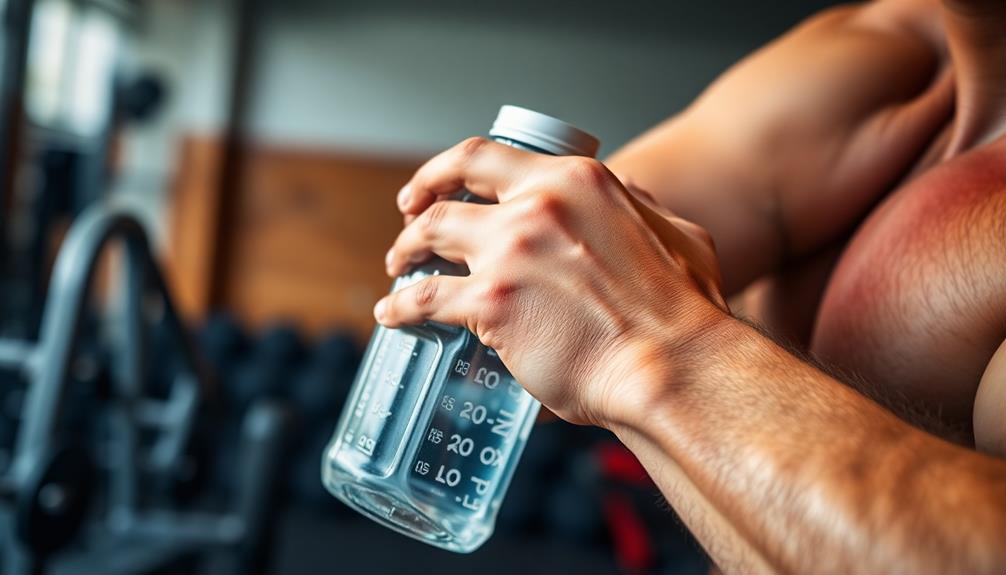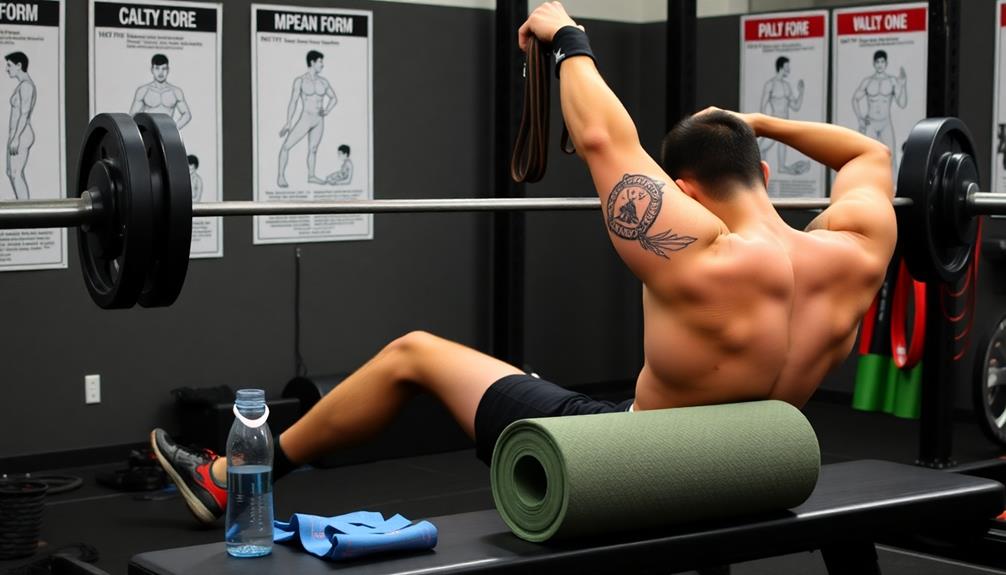To prevent injuries after heavy lifting, follow these seven essential tips: cool down properly, use foam rollers for self-massage, stay hydrated, eat a balanced recovery meal, prioritize quality sleep, incorporate active recovery days, and perform regular mobility work. Start by gradually lowering your workout intensity, then stretch and foam roll the muscles you've worked. Drink plenty of water and eat a mix of protein, carbs, and healthy fats. Aim for 7-9 hours of sleep nightly, and include light activities on rest days. Don't forget to maintain flexibility with targeted mobility exercises. These strategies will help you recover effectively and stay injury-free.
Core Insight
- Perform a proper cool-down routine, gradually lowering intensity and stretching worked muscles for 15-30 seconds each.
- Use foam rollers and self-massage techniques to release muscle tension and improve flexibility post-workout.
- Stay adequately hydrated by drinking water or electrolyte drinks to prevent muscle cramps and fatigue.
- Consume a balanced meal with protein, carbs, and healthy fats to support muscle recovery and reduce inflammation.
- Prioritize quality sleep and incorporate active recovery days to prevent stiffness and promote overall muscle health.
Proper Cool-Down Techniques

Cooling down after lifting weights is crucial to avoid injury and help your body recover. Start by slowly lowering the intensity of your workout for 5-10 minutes. This can mean doing some light cardio or body weight exercises. Then, stretch each muscle you worked during lifting, holding each stretch for 15-30 seconds.
Foam rollers are great tools for releasing muscle tension and improving flexibility. You can use them as part of your cool-down to help your muscles relax.
Make sure to drink plenty of water or an electrolyte drink to rehydrate your body. Using a foam roller or massage ball can also help release muscle tension and improve blood flow, which may lessen soreness.
Foam Rolling and Self-Massage

Foam rolling and self-massage are great ways to help your muscles recover after a workout. When you finish lifting weights, focus on the main muscle groups you worked. Start with your legs by rolling your quads, hamstrings, and calves for 30-60 seconds each. Then, move to your back and roll the lower and upper parts. Make sure to also roll your glutes and shoulders. A high-density foam roller with bumps or ridges can help you massage deep into the muscle and relieve knots. These special rollers improve blood flow and target specific areas.
As you roll, apply firm, consistent pressure. If you find a tight spot, pause there for 10-15 seconds. Take deep breaths to help your muscles relax. If an area feels very sore, ease up a bit but don't skip it entirely. Often, these tender spots need the most attention.
For self-massage, use your hands or a massage ball to work out knots. Use circular motions and gentle kneading. The goal is to improve blood flow and reduce muscle tension, not to cause pain.
Adequate Hydration

Water is your body's best friend after lifting weights. It helps rehydrate your muscles and speeds up recovery. Replace the fluids you lost from sweating during your workout. Proper hydration stops muscle cramps, fatigue, and soreness. Sports drinks with electrolytes and minerals can boost performance and recovery.
To rehydrate well after exercising:
- Drink 16-20 ounces of water within a half hour of finishing
- Keep drinking water throughout the day
- Check your pee color; pale yellow means you're hydrated
- Try electrolyte drinks if your intense workout was over an hour
Balanced Nutrition for Recovery

Proper nutrition is crucial for recovering from intense workouts. Eat a balanced mix of protein, carbs, and healthy fats. Protein helps repair and build muscle, so choose lean meats, fish, or plant-based sources. Complex carbs from whole grains, fruits, and veggies refill energy stores and support recovery. Healthy fats reduce inflammation and support hormones. Plant-based athletes can use vegan supplements for an extra nutritional boost.
Eat within 30 minutes post-workout to kick-start recovery, combining protein and carbs. Keep fueling your body with nutrients during the day to help continuous repair. Adjust your diet as needed based on your goals and how your body responds, since everyone's needs are unique.
Quality Sleep and Rest

Sleep is the best way to help your body recover after lifting weights. While you sleep, your muscles repair themselves and get stronger. To get the most out of your recovery, try to sleep 7-9 hours each night. Make your bedroom dark, cool, and quiet to create a good sleeping environment. If you have pain or swelling after working out, taking supplements that reduce inflammation can help you recover and sleep better.
Follow these four simple tips to sleep better:
- Go to bed and wake up at the same times every day
- Don't have caffeine or use electronics right before bed
- Try relaxation methods like deep breathing or meditation
- Get a good mattress and pillows that support your body
Rest days and naps are important too, not just sleep at night. Take at least one full day off from working out each week so your body can fully recover. Quick power naps that are 15-20 minutes long can give you more energy and help your muscles recover without messing up your sleep at night.
Active Recovery Days

Active recovery days are important for staying fit and avoiding injury after tough workouts. On these days, do light activities that get your blood moving and help your muscles heal. Good options are walking, swimming, or easy yoga. Using a foam roller can also help your muscles recover and stay flexible.
During active recovery, focus on exercises that improve your range of motion and stretching to boost flexibility and relax tight muscles. This helps stop you from getting stiff and sore after hard workouts. Make sure to drink plenty of water and eat well to support your body's healing process.
Regular Mobility Work

Regular mobility work offers more benefits than active recovery days alone. It helps maintain flexibility, prevent stiffness, and lower your risk of injury after lifting heavy weights. Using massage balls for myofascial release can make your mobility routine even better by targeting specific muscles and trigger points. Adding mobility exercises keeps your joints and muscles working well.
When doing mobility work, focus on these four main areas:
- Hip flexors and glutes
- Shoulders and upper back
- Ankles and calves
- Thoracic spine
Frequently Asked Questions
How Long Should I Wait Before Lifting Heavy Again After an Intense Session?
You should wait at least 48-72 hours before lifting heavy again after an intense session. This allows your muscles to recover and rebuild. Listen to your body; if you're still sore, give yourself more time to rest.
Are Ice Baths Beneficial for Recovery After Heavy Lifting?
Ice baths can be beneficial for recovery after heavy lifting. They may reduce inflammation and muscle soreness. However, you shouldn't rely on them solely. It's best to combine ice baths with other recovery methods for best results.
Can Certain Supplements Help Prevent Injuries From Heavy Lifting?
You'll find some supplements can help prevent lifting injuries. Consider omega-3s for inflammation, collagen for joint health, and vitamin D for bone strength. However, don't rely solely on supplements; proper form and technique are essential.
What Are Signs That I'm Overtraining and at Risk of Injury?
You're likely overtraining if you're experiencing persistent fatigue, decreased performance, mood changes, insomnia, or frequent injuries. You might also notice increased resting heart rate, loss of appetite, and prolonged muscle soreness. Don't ignore these warning signs.
How Do I Modify My Lifting Routine as I Age to Prevent Injuries?
As you age, focus on gradually reducing weight and increasing reps. Incorporate more rest days, prioritize form over heavy lifting, and include flexibility exercises. Listen to your body, and don't push through pain. Consider working with a trainer.

